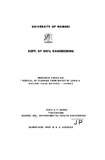| dc.description.abstract | This research investigated the potential for the removal of fluoride from water by use of a natural local material - chokaa. The material investigated is mined from quarries in Muranga, Kenya and is locally referred to as "chokaa" (Swahili for chalk). A number of methods have been investigated at the experimental level, of their potential to remove fluoride in Kenyan water. These include bone charcoal, charcoal from coffee husks, clay and activated alumina. These methods have been found to be either too costly or simply inappropriate for the Kenyan situation. Removal of excess fluoride is the only major form of treatment required for groundwater in several areas of the country; it is with the desire to develop a cheap and effective de-fluoridation technique, that the need to investigate a locally available material's potential seems necessary. Batch experiments were carried out to determine vanous parameters like the optimal mass of chokaa required, the equilibrium time, effect of sorbent particle size, nature and rate of the sorption process, and the effect of pH and temperature. It was found that chokaa removed at least 70% of the fluoride ion in water at a pH of between 6.8 -7, temperature 2SoC, and equilibrium time of one hour, for an original fluoride concentration of 2Sppm. The optimal mass for SOml fluoride ion solution was 109. The equilibrium data fitted the Freundlich adsorption model. Bench scale column studies were also carried out. The column dimensions were height, 2S.2cm diameter, 3.4cm and operated at 49.Scm head of water. The initial fluoride concentration was 9.Sppm and water flow rate of 4ml/min. The effluent fluoride concentration from the treated water was 1.3ppm. The column treated 220ml of water before regeneration, it was regenerated and operated again. After regeneration, 9.Sppm fluoride ion concentration was reduced to 1.Sppm at a flow rate of 3.Smllmin. The flow in the column was between 0.264 mlhr and 0.033m1hr which is comparable to a slow sand filter (0.02 - 0.2m1hr for 1000 - 2000m2 bed). The bed volume for the column was 229cm3 and treated 220ml volume of water before the filter was regenerated. After regeneration the bed volume treatment was 209ml. The mass of fluoride ions sorbed per unit mass of chokaa, Qe, for column studies was O.Olmg/g while for batch studies, it was 0.096mg/g this shows that the fluoride removal for batch was better, however a batch setup is not ideal for industrial scale application. The use of chokaa was found to be an effective method of removing fluoride from Kenyan water. However it's regeneration cost was about Kshs. 72 per litre of water which appears rather expensive. The cost could reduce if treatment is on a large scale. | en |

